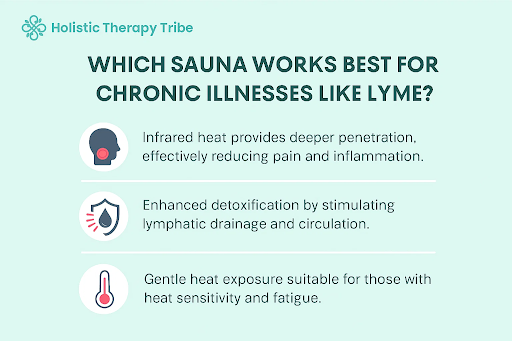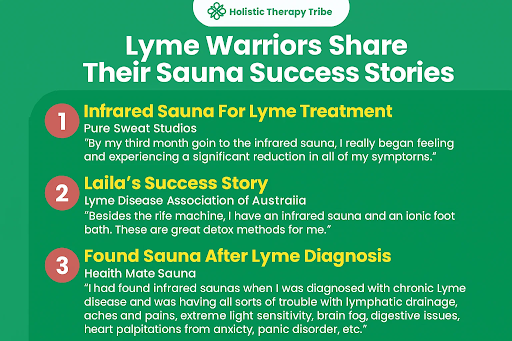
Visualize stepping in a warm environment where the heat is penetrated and that helps you heal from all your debilitating symptoms. Relaxing, right?
Now, what if I inform you that this heat will aid in fighting Lyme disease? Could infrared therapy really help with the healing and relief from Lyme disease?
Infrared saunas are becoming a popular choice for Lyme disease sufferers. Let us see if that is really an answer to the healing journey for the individuals with Lyme disease.
We will explore how infrared sauna therapy really works and how that might as well benefit Lyme warriors..
Can Heat Relieve Lyme’s Most Debilitating Symptoms?
Infrared work on the simple mechanism of using light that generates heat, which thereby penetrates deeper into the skin. Individuals opt for traditional saunas, thereby allowing the therapeutic effects of it to reach the joint, muscles, tissues, and so on that needs relief.
This power has an absolute advantage in dealing with lyme disease symptoms.
- Pain Management: Infrared sauna therapy helps in enhancing the circulation and improving the blood flow to the affected areas. The heat that is precipitated stimulates the natural healing mechanism of the body. Now, let us resonate with the symptoms of the Lyme disease such as muscle spasms, stiffness, and nerve pain, and son. The heat promotes a state of healing and relaxation for these progressive symptoms.
- Fatigue Minimization: Fatigue is one of the hallmark symptoms of Lyme disease. Often leaving individuals feeling drained, even after a full night’s rest. The infrared heat boosts energy levels as it increases oxygenation and nutrient delivery throughout the body. It boosts and elevates the energy throughout the day.
- Reduction in Inflammation: Chronic inflammation is linked to Lyme disease and the co-infections linked to it. Infrared sauna therapy aids in minimizing inflammation and promotes lymphatic drainage, and boosts the detoxification ability of the body. This results in less swelling, pain, reduction in “inflammation fog” that accompanies Lyme disease.

Infrared Sauna vs. Traditional Sauna: Which Is Better for Lyme?
When it comes down to managing Lyme disease and its symptoms, many patients turn to sauna therapy as a natural and effective way to promote healing, detoxification, and relief.
1.Traditional Sauna: A traditional sauna operates by heating the air to a high temperature. This heat creates sweating and a sense of relaxation. The common types are either wood-burning or electric saunas.
How it Works
| Key Benefits
| Limitations
|
2. Infrared Sauna: This works quite differently. Infrared saunas use infrared light to heat the body instead of heating the air in the room. This type of heat penetration is quite deep, with up to 3 inches into the tissues, allowing the heat to target muscles, joints, and even cellular-level inflammation.
How it Works
| Key Benefits
| Limitations
|
When and How to Use Infrared Saunas Safely
We have understood the significant benefits, limitations with respect to saunas and Lyme disease healing. But what is the proper timing? What can be the potential session length? Let us take a look at this.
1.Time: To maximise the therapeutic benefits of infrared saunas, timing is quite crucial.
- If you are new to sauna therapy or in the early stages of Lyme disease, start with relatively shorter sessions.
- Use the sauna in the morning or early afternoon when the energy levels are naturally heightened. This can enhance and increase relaxation and reduce inflammation.
- Take into consideration your symptoms. For instance, chronic pain, fatigue, or muscle stiffness related to Lyme disease can be healed by early sauna sessions more effectively.
- During the treatment, the detoxification phase can be best incorporated through sauna sessions.
2.Lengths and Frequency: To prevent overstimulation and to receive full benefits of infrared sauna therapy, this is also vital.
- As mentioned, opt for 10-15 minutes during the initial stage so the body can gradually accustom itself to the heat sessions.
- Once your body is comfortable with the presenting symptoms being pressed by the sauna sessions, aim for 20- 30 minute sessions per sauna use. However, this criterion varies from individual to individual.
- Initially, aim for 2-3 sessions per week. And once you have built tolerance, you can increase the sessions to 4-5 sessions per week, depending on your symptoms and treatment goals.
Precautions and Contraindications
- Individuals with Cardiovascular conditions: Individuals dealing with Lyme disease who have cardiovascular conditions like hypertension, heart disease, or those who have had a history of heart attack should avoid infrared saunas or use them under medical supervision.
- Pregnant Women: Lyme disease in pregnant women showcases multiple symptoms. Infrared saunas might elevate all those due to the condition called Hyperthermia. Consulting the healthcare provider if one wants to engage in sauna use during pregnancy is required.
- Heat Sensitivity: Individuals who have low heat tolerance or intolerance can significantly worsen the symptoms due to increased body temperature, which they cannot withstand. This can lead to dizziness, fatigue, exaggerated symptoms, and so on.
- Skin conditions: The heat and sweat can significantly aggravate skin conditions, leading to elevated irritation or flare-ups.
- Overuse or Dehydration: Both of these can lead to worsening of the symptoms, especially for those already dealing with Lyme disease or chronic illness.
Conclusion
- Infrared sauna therapy has emerged as a promising complementary treatment for those battling Lyme disease, offering benefits such as pain relief, reduced inflammation, and enhanced detoxification.
- Research supports the potential of infrared saunas in boosting circulation, improving immune function, and promoting relaxation, all of which are crucial for Lyme disease recovery.
- For Lyme disease patients, infrared sauna therapy offers a safe, non-invasive option that can provide relief and improve overall well-being, but it should always be used with proper guidance from a healthcare provider.
What’s Next for You?
Ready to explore a more complete path to recovery? Join the Lyme Support Network Community.
References
- Hamblin MR. History of Low-Level Laser (Light) Therapy. In: Hamblin MR, de Sousa MVP, Agrawal T, editors. Handbook of Low-Level Laser Therapy. Singapore: Pan Stanford Publishing; 2017. [Google Scholar]
- Anders JJ, Lanzafame RJ, Arany PR. Low-level light/laser therapy versus photobiomodulation therapy. Photomed Laser Surg. 2015;33:183–184. doi: 10.1089/pho.2015.9848. [DOI] [PMC free article] [PubMed] [Google Scholar]
- Hamblin MR, de Sousa MVP, Agrawal T. Handbook of Low-Level Laser Therapy. Singapore: Pan Stanford Publishing; 2017. [Google Scholar]
- de Freitas LF, Hamblin MR. Proposed mechanisms of photobiomodulation or low-level light therapy. IEEE J Sel Top Quantum Electron. 2016;22:348–364. doi: 10.1109/JSTQE.2016.2561201. [DOI] [PMC free article] [PubMed] [Google Scholar]
- Wang Y, Huang YY, Wang Y, et al. Photobiomodulation (blue and green light) encourages osteoblastic-differentiation of human adipose-derived stem cells: role of intracellular calcium and light-gated ion channels. Sci Rep. 2016;6:33719. doi: 10.1038/srep33719. [DOI] [PMC free article] [PubMed] [Google Scholar]
- Wang L, Jacques SL, Zheng L. MCML—Monte Carlo modeling of light transport in multi-layered tissues. Comput Meth Prog Bio. 1995;47:131–146. doi: 10.1016/0169-2607(95)01640-f. [DOI] [PubMed] [Google Scholar]






